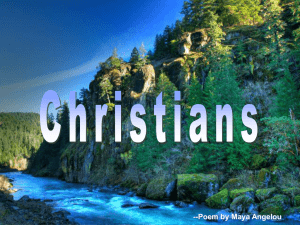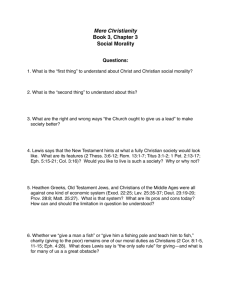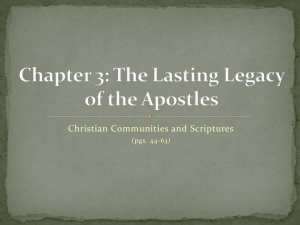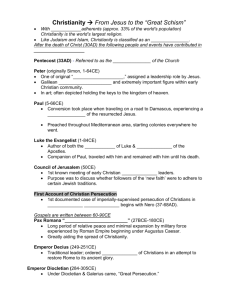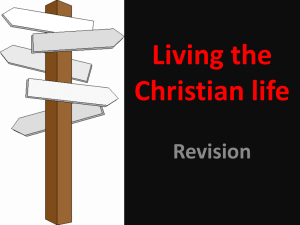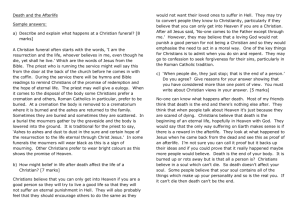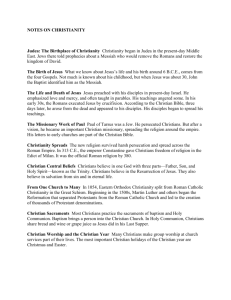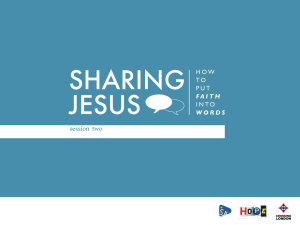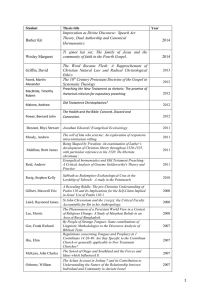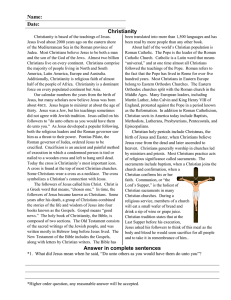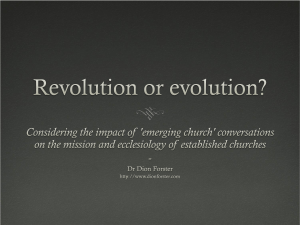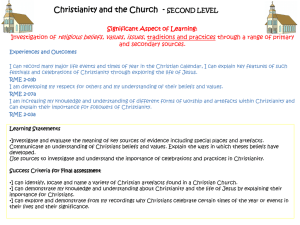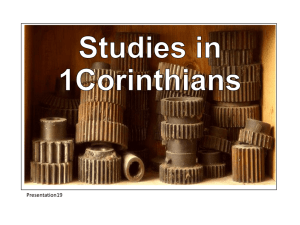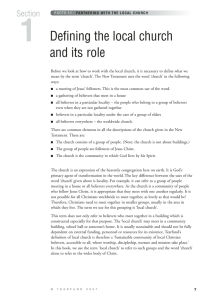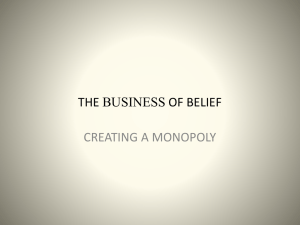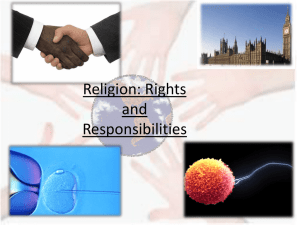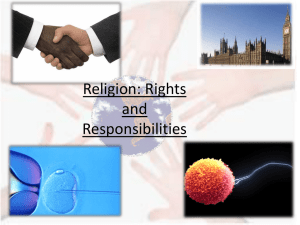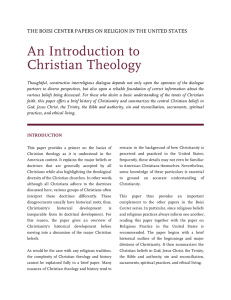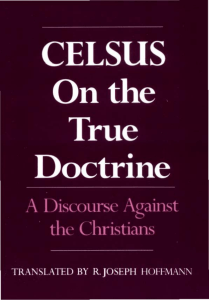A Review/Study Guide for the New Testament
advertisement
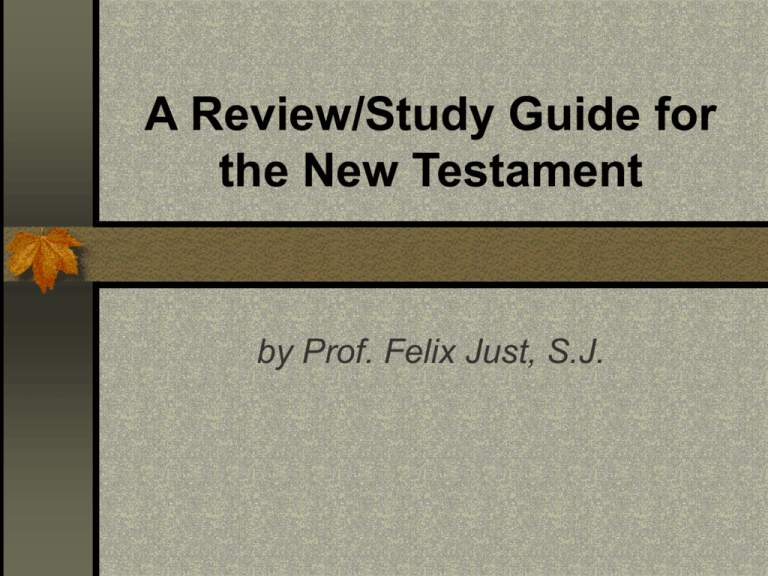
A Review/Study Guide for the New Testament by Prof. Felix Just, S.J. Twenty-four Questions Seeking Brief Responses: (Objective Part of the Final Exam) 1. What are the definitions & original meanings of: "Philosophy" & "Theology," "Religion" & "Faith," "Christianity" & "Church"? 2. Define & distinguish: Bible, Testament, Apocrypha, scripture, canon, genre, Gospel, Acts, Epistle, Homily, Apocalypse, etc. 3. Define & contrast: primary/secondary literature, manuscripts/print editions, papyrus/vellum, scroll/codex, exegesis/eisegesis, etc. 4. What are the main differences (in language, date, divisions, order, number & titles of books) between the HB & the LXX? 5. How & why is the Old Testament slightly different in Orthodox, Catholic, and Protestant Bibles? Is the NT different? 6. When & by whom was the Hebrew Bible "canonized“? What were the main criteria? [Same questions also for the NT.] 7. Name & describe the "seven pillars of ancient Judaism.“ How are these related to the main "covenants" of the Hebrew Bible? 8. How are some key OT characters (Adam, Abraham, Jacob, Moses, David, Elijah, Isaiah, Ezekiel, Daniel, etc.) used in the NT? 9. What were the main groups or "sects" within ancient Judaism at the time of Jesus? How were they different from each other? 10. Name all 27 NT books in canonical order. Name the 7 "undisputed" Pauline letters in their most likely chronological order. 11. Name & briefly explain the 4 "criteria for canonicity" and the 10 stages (esp. 1-4!) in the formation & transmission of the NT. 12. Briefly explain the "four-fold role of the Evangelists" as authors. What are the "attributed" vs. "implied" vs. "actual" authors? 13. How & why are the canonical Gospels similar to "ancient biographies," and how are these different from modern biographies? 14. What are the "rules of thumb" and the "specific criteria" scholars use to determine the historical accuracy of Jesus traditions? 15. What is the "Synoptic Problem"? Diagram & explain the "Four-Source Theory" preferred by most scholars today as its solution. 16. What is the "theological geography" or structural outline of the Acts of the Apostles? How is Acts related to Luke's Gospel? 17. What is the overall "literary structure" (main sections & subsections) of Paul’s letters & most other early Christian epistles? 18. What are the particular problems addressed and the main themes discussed in each of the NT letters & epistles? 19. What is "pseudepigraphy"? Why are the six deutero-Pauline letters considered "pseudepigraphic" by many scholars? 20. Name the "Pastoral Letters" & the "Catholic Epistles." What do "pastoral" & "catholic" mean? By & to whom were they written? 21. What is the literary genre of the so- called "Letter to the Hebrews"? Why is it not really a "letter"? Who is its (implied) author? 22. What is the literary genre of the "Book of Revelation"? What are the main characteristics of "apocalyptic" literature? 23. What happened in the years 4 BC, and AD 30, 50, 70, 90? Why & how are these dates & events important for NT studies? 24. Why are there so many discrepancies in NT manuscripts? How do textual critics determine the most likely original readings? Twenty-four Questions Needing Essay Answers: Essay Part of the Final Exam 1. What are the main characteristics of "apocalypticism"? Why is early Christianity often considered an "apocalyptic" movement? 2. What does each of the Gospels say about Christology and discipleship, and how are these teachings related to each other? 3. What is the basic outline of each canonical Gospel? What are the major literary features and thematic emphases of each? 4. How is the Fourth Gospel (John) different from the Synoptics (Matt, Mark, Luke) in content, chronology, style, and theology? 5. How is the community life of the early Christians portrayed in Acts 14? How are the apostles portrayed throughout Acts? 6. What are the five main phases of Saul/Paul's life? Where was he (& when & why) during each of these phases? 7. Who were Paul's main missionary associates? How did he relate differently to his "full partners" vs. his "junior associates" vs. his "converts"? 8. Describe some major differences between ancient & modern times in prisons/trials, slavery, travel, roads, mail, etc. 9. What are the main differences between the eschatology (end-time teachings) of 1 Thess and that of 2 Thess? 10. How did Paul feel towards the Christians at Philippi? How did they help him? What was the role of Epaphroditus? 11. Describe Paul's complex interactions with the Christians in Corinth? What main issues are addressed in 1 Cor & 2 Cor? 12. What does Paul say about the "resurrection of Jesus" & the "resurrection of the body" in general in 1 Cor 15? 13. Who are Philemon and Onesimus? How are they related to Paul, and what does Paul want each of them to do? 14. What does Paul tell his Gentile- Christian converts in Galatia about circumcision and other Jewish ritual laws, and why? 15. How does the Olive Tree metaphor illustrate Paul's teaching in Romans 11 about the relationship between Jews & Gentiles? 16. Compare & contrast what James & Paul say about "faith vs. works." Why do their teachings apparently but not actually contradict each other? 17. What is the main purpose of the "Household Codes" in Colossians & Ephesians? Which groups are mentioned in them? 18. How do 1 Timothy & Titus describe the leadership structure of local Christian communities? How is it different from local church leadership structures today? 19. Why & how does the Epistle to the Hebrews justify calling Jesus a "great high priest, according to the order of Melchizedek"? 20. According to 1 Peter, how are Christians supposed to respond to persecutions? What is the role of suffering for Christians? 21. What does 2 Peter say about the second coming of Jesus, the end of the world, and the reason for the "delay of the parousia"? 22. According to the letters of John & Jude, what were some major causes of division within or between early Christian churches? 23. What was the purpose and the original audience of the Book of Revelation? Describe its outline, content, and main symbolism. 24. Name & describe some early Christian writings that were not included in the NT. How is this literature still important today?
